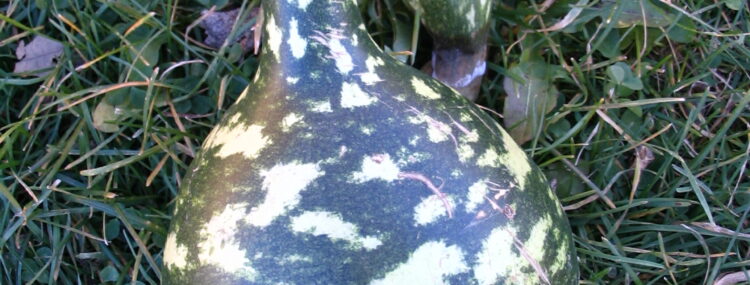
Gourds (Orn.)
Children will get a real treat out of growing their own plants of these unusual varieties. Maybe they will learn how to attract birds thru their own homemade bird gourd nests!
Will remain online for educational purposes. Operating on a “hobby” basis.
Occasionally we may have “extra” seed. Pkts. marked below. If nothing marked…then it is “N/A”.
- Birdhouse Gourd – (aka Bottle Gourd) Light green fruits with elongated necks and bulbous bases (or rather hour-glass shaped…) ranging from 7-14” in diameter. The large round base is chuck full of seeds. Harvest when the smooth greenish rind turns white or starts to brown. Dry out inedible fruits for fancy table decorations or for durable bottles, birdhouses, etc. Vines can reach 15 – 35 ft.! Can be trained to grow on a trellis or fence for cleaner harvests. Harvest carefully before frost, as any bruising causes them to rot and your long-awaited “project” will be ruined! 100-120 days.
- Crown of Thorns – A heritage variety. A mix of green, beige and white “squash” with pointed tips resembling the biblical “Crown of Thorns” vines. Fruits can be dried. Harvest very carefully as bruising causes immediate decay. Glaze clean, totally dried fruits with floor wax to help preserve the skin. Will finish in a normal zucchini season.
- Japanese Nest Egg – an interesting fine egg-shaped member of this strange family. Apparently very popular in the early 1800’s…as these dried to the color of pale white/grey and could be then painted with gorgeous patterns and pictures. Sometimes these were cut away and tiny images and scenery were placed inside. A novel variety…for crafters.
- Luffa Sponge Gourd – the vines of this unusual variety will reach 8-15 ft. Grow your own Luffa sponges! The fibrous internal structure converts into a sponge after maturing to 12” long and 3-4” wide. Let dry until outer skin can be peeled away. Then disinfect and dry further. Needs trellising to grow straight. It is important to hand pollinate the female flowers (those with tiny green gourds on) or you will not have any fruits & the little bulbs will fall off! Needs a long warm (+18C) growing season to develop fruits. Could possibly be grown in pots and then safe-guarded from cool temperatures. Late season developer@ 120-160 days
- Small Fruited Daisy – this mixed collection comes in an assortment of shapes, colors and patterns. The mature gourds will have a flower like appearance. A lovely and interesting mix…fun for the kid-lets! 95 days
- Snake Polo – Hummm…might frighten poor Nana/Granny as she is making her rounds in your garden! Looks for all the world like a dark green serpent with some light colored lines, laying in the vines and leaves. Will reach about 30″ (by me…) Skin is not too smooth and diameter was about 2″ in diameter. Vines, if trellised can reach about 8 feet. According to those that know, can be eaten when young…sliced in 1 1/2″ rings, salted,stuffed and baked. When older will taste bitter and may not be as tasty or useful. Will dry to a smooth surfaced light and dark brown/grey skinned long gourd. Long season grower, preferring to take off (production wise) when it gets cooler, like it did here in Sept. 85-100 days
- Speckled Swan Gourd – Thick dipper-shaped fruits that resemble swans swimming on a pond with their necks curved! Great unique item for crafting. These large emerald green 10″ to 12″ fruits have white speckles all over them while still green. Will change to tan when dried. Pick gourds when entire vine is dry and brown. Handle gently and turn weekly as gourds dry in a warm, airy place. Do not cut or decorate (paint) until completely dry and the seeds rattle inside. 100-120 days
- Ten Commandments Gourd – Extensive collection & mixture of brightly striped, mottled and multicolored fruits…a standard in most fall decorations. Soft-ball-sized fruits have 5 pairs of protruding prongs that point towards (cupped…) its blossom end. 95 days.
